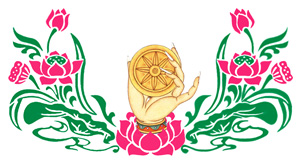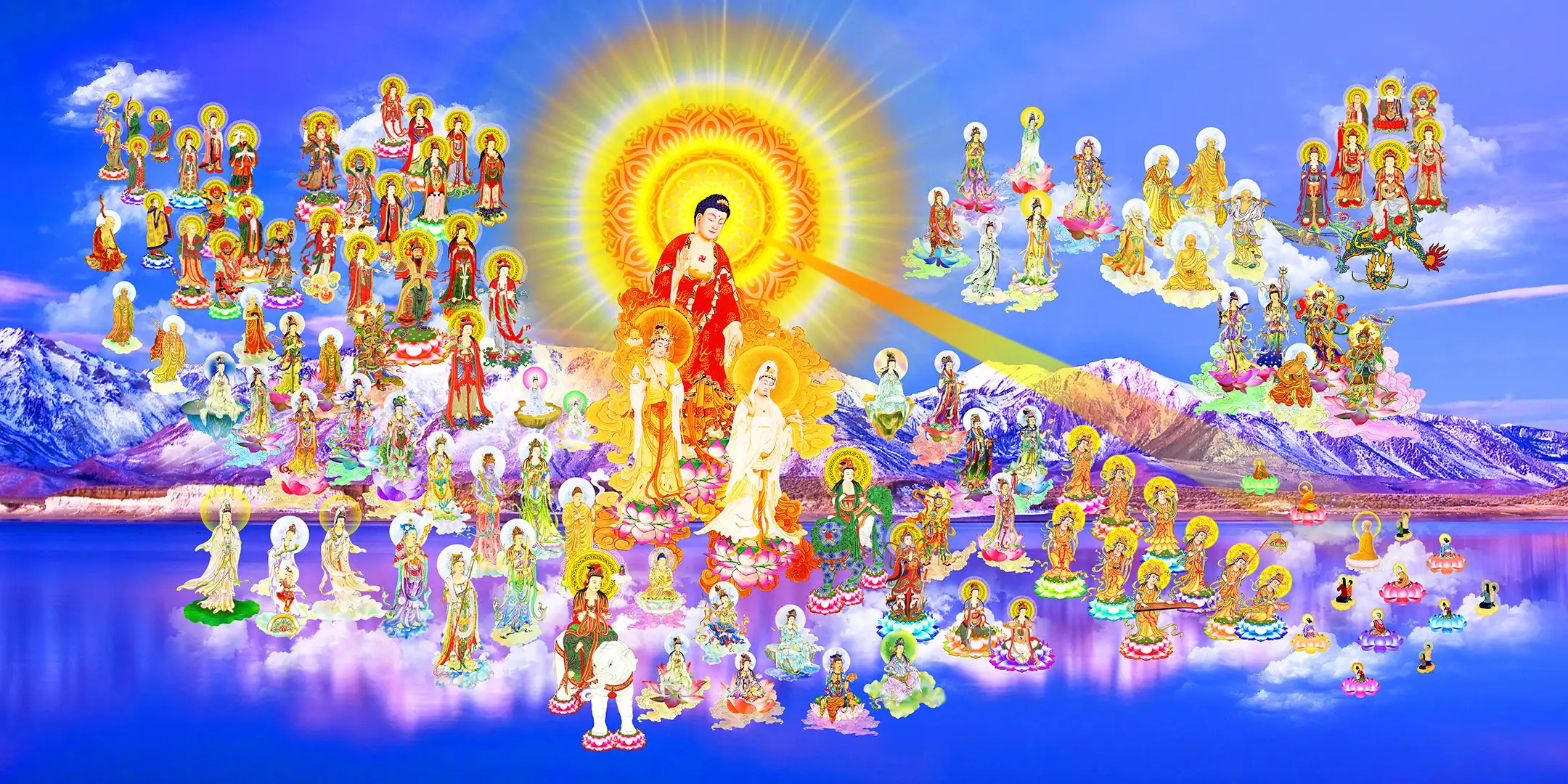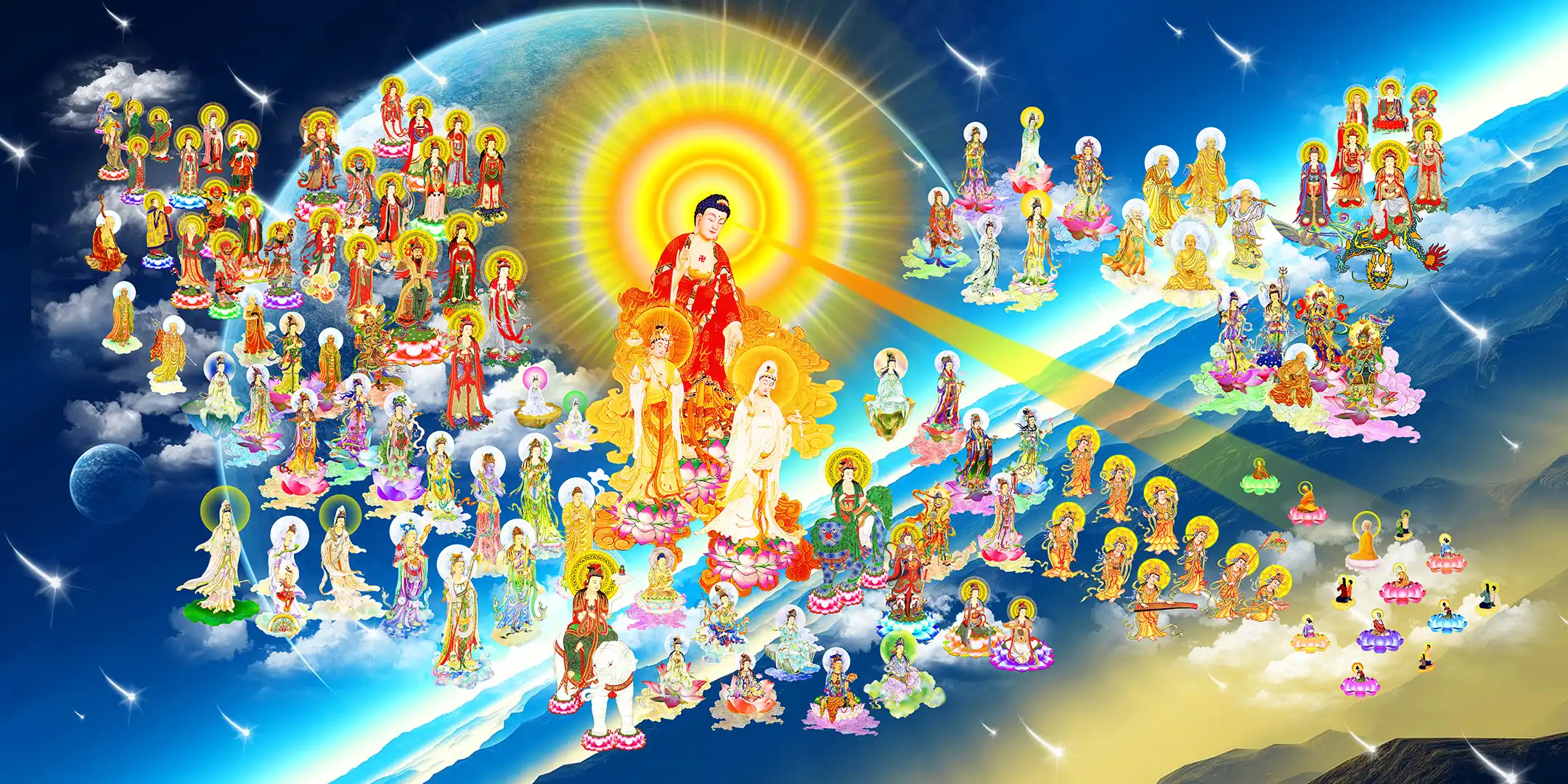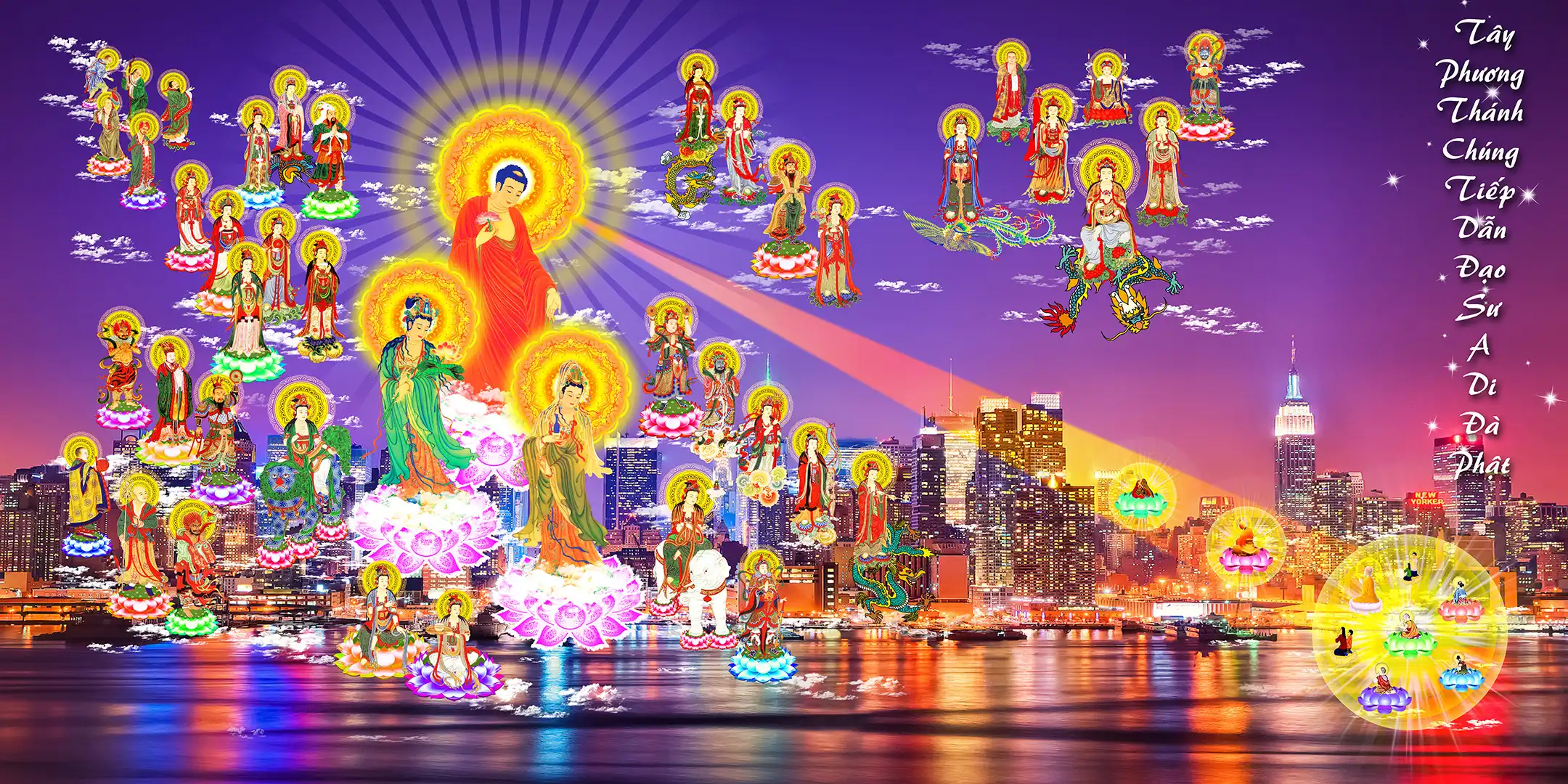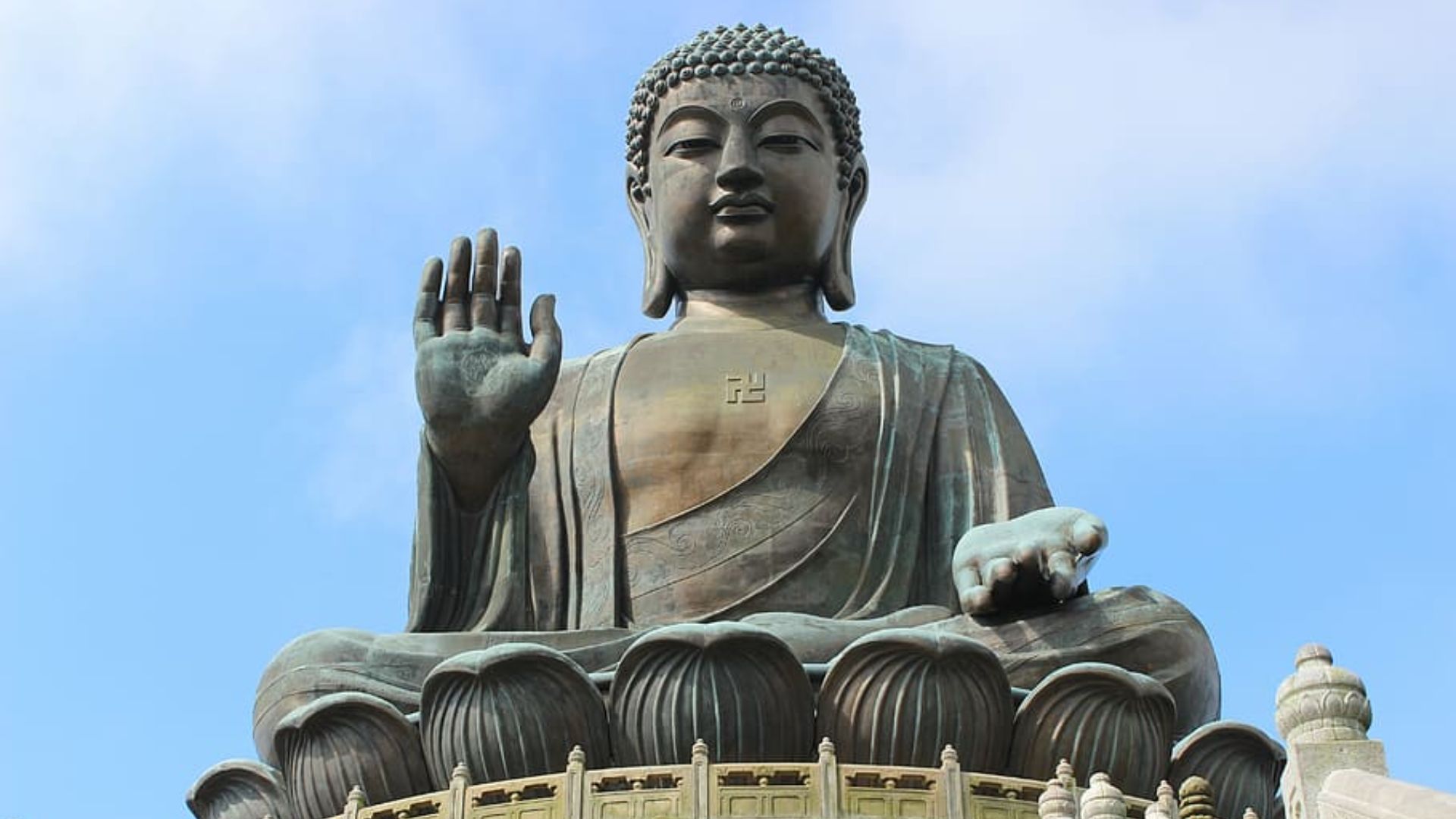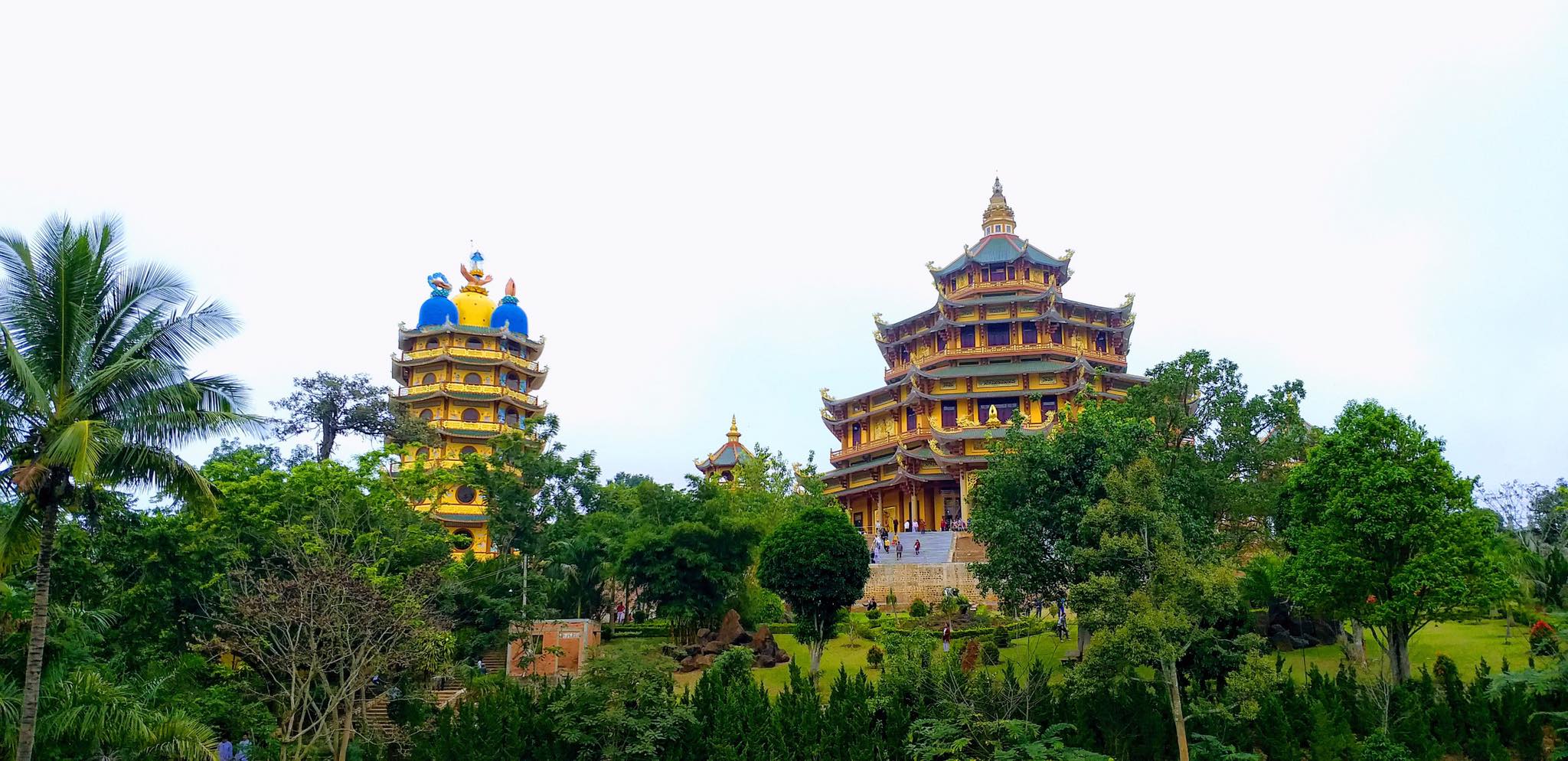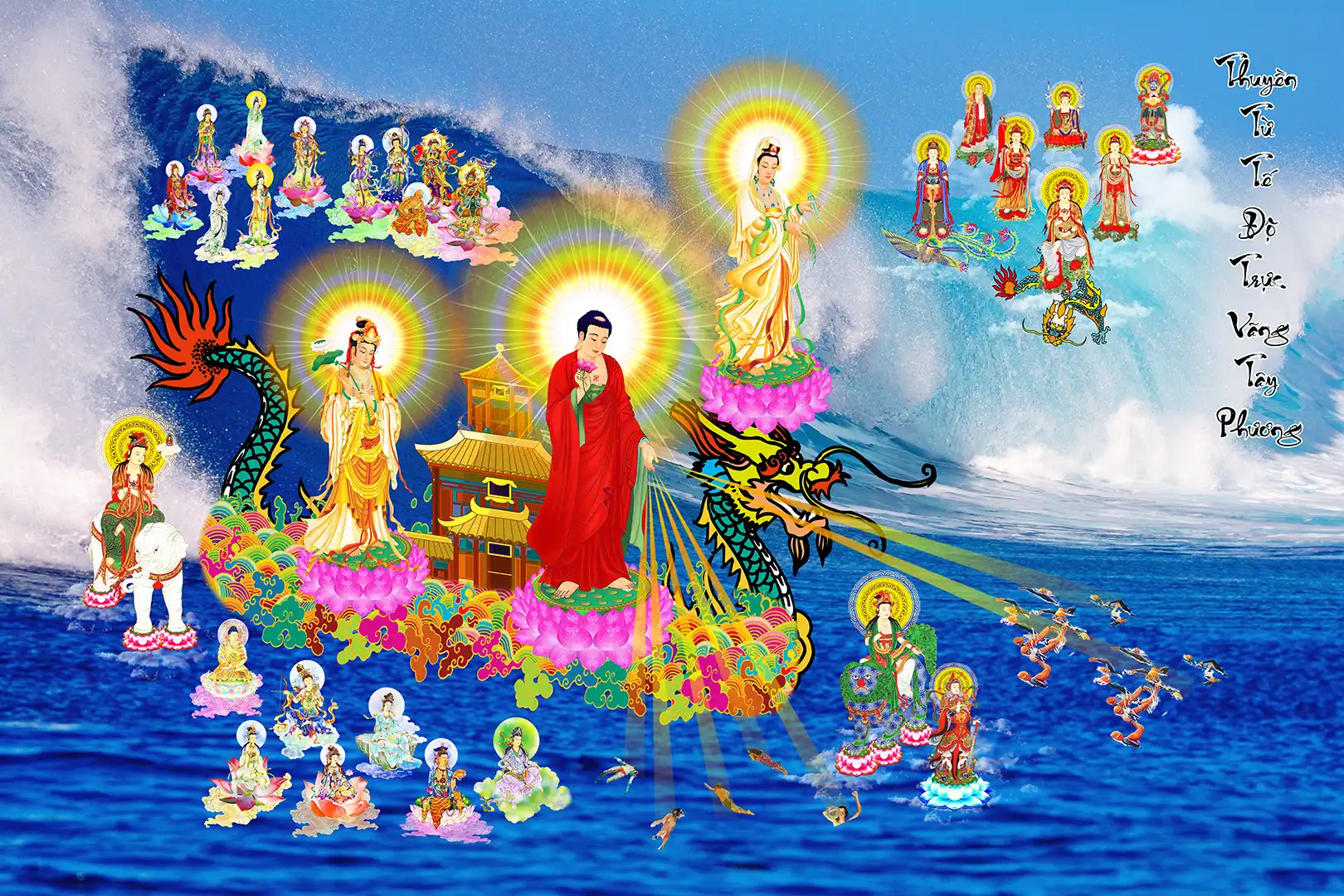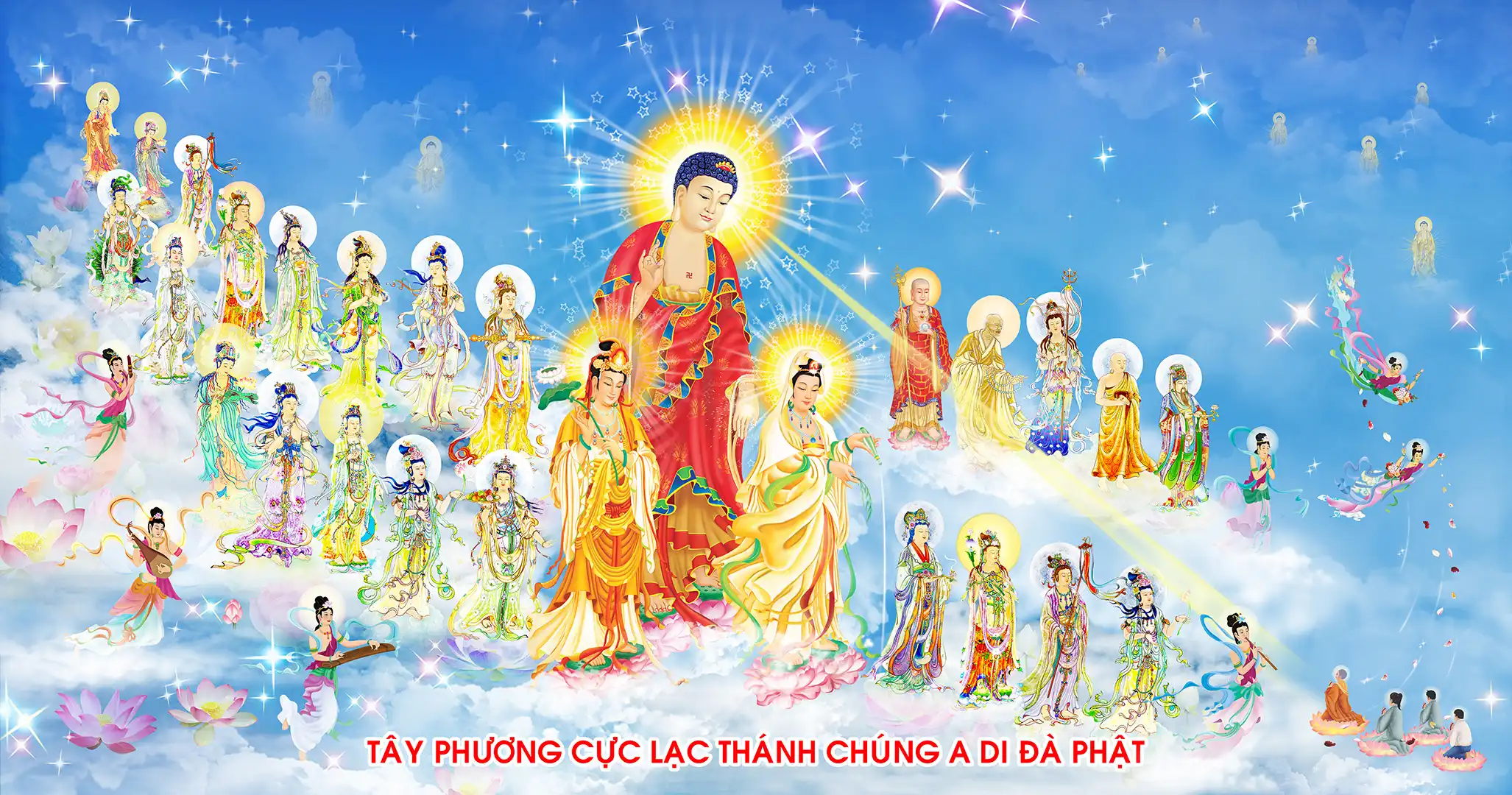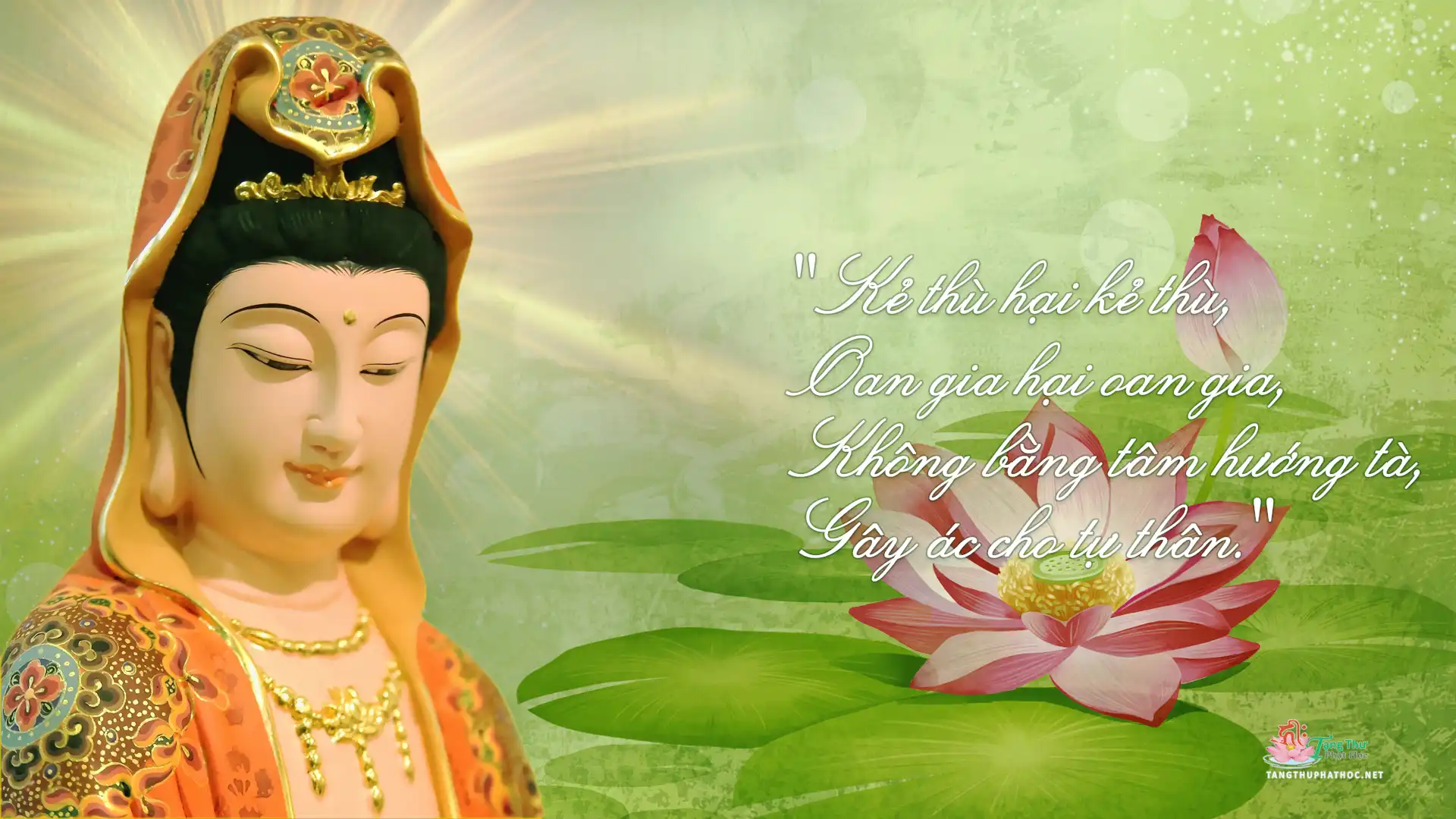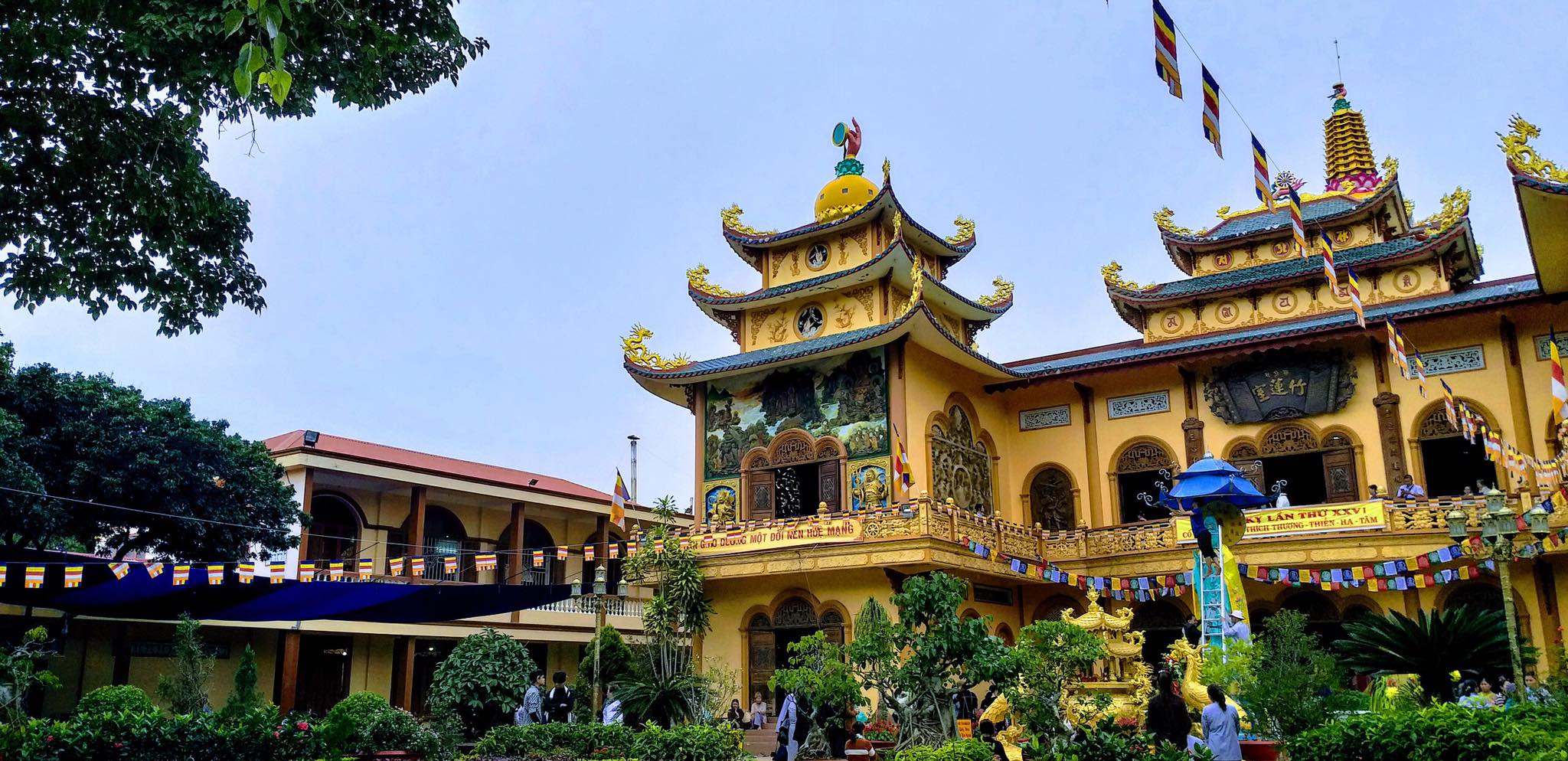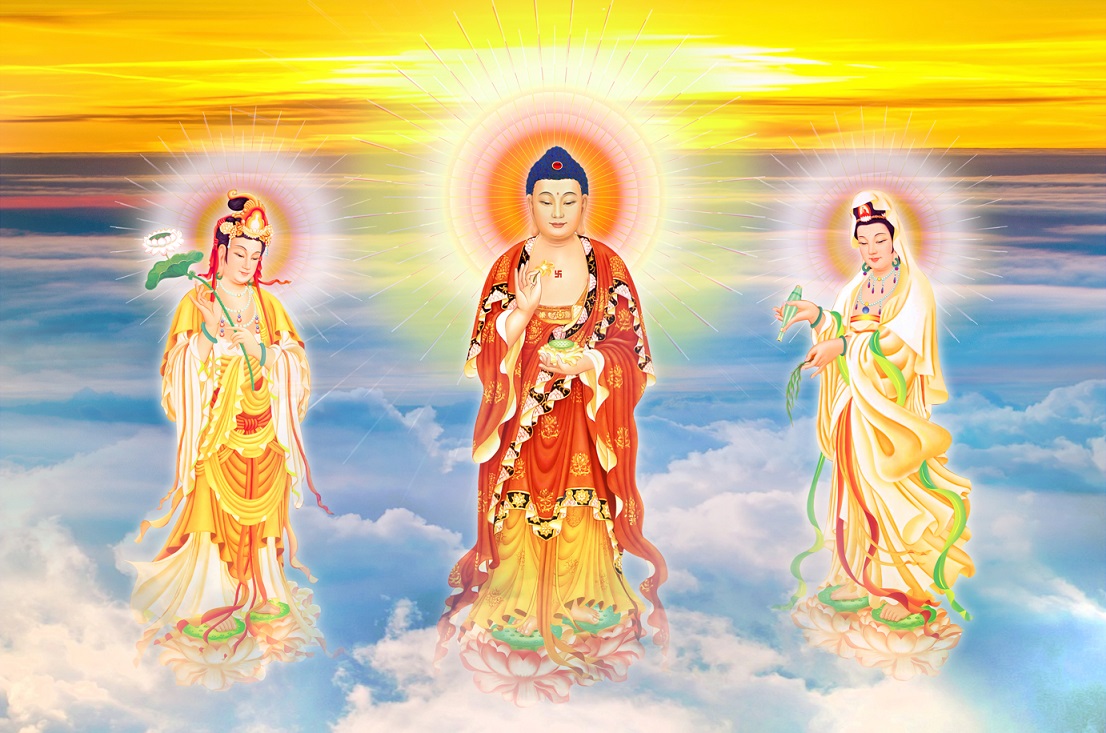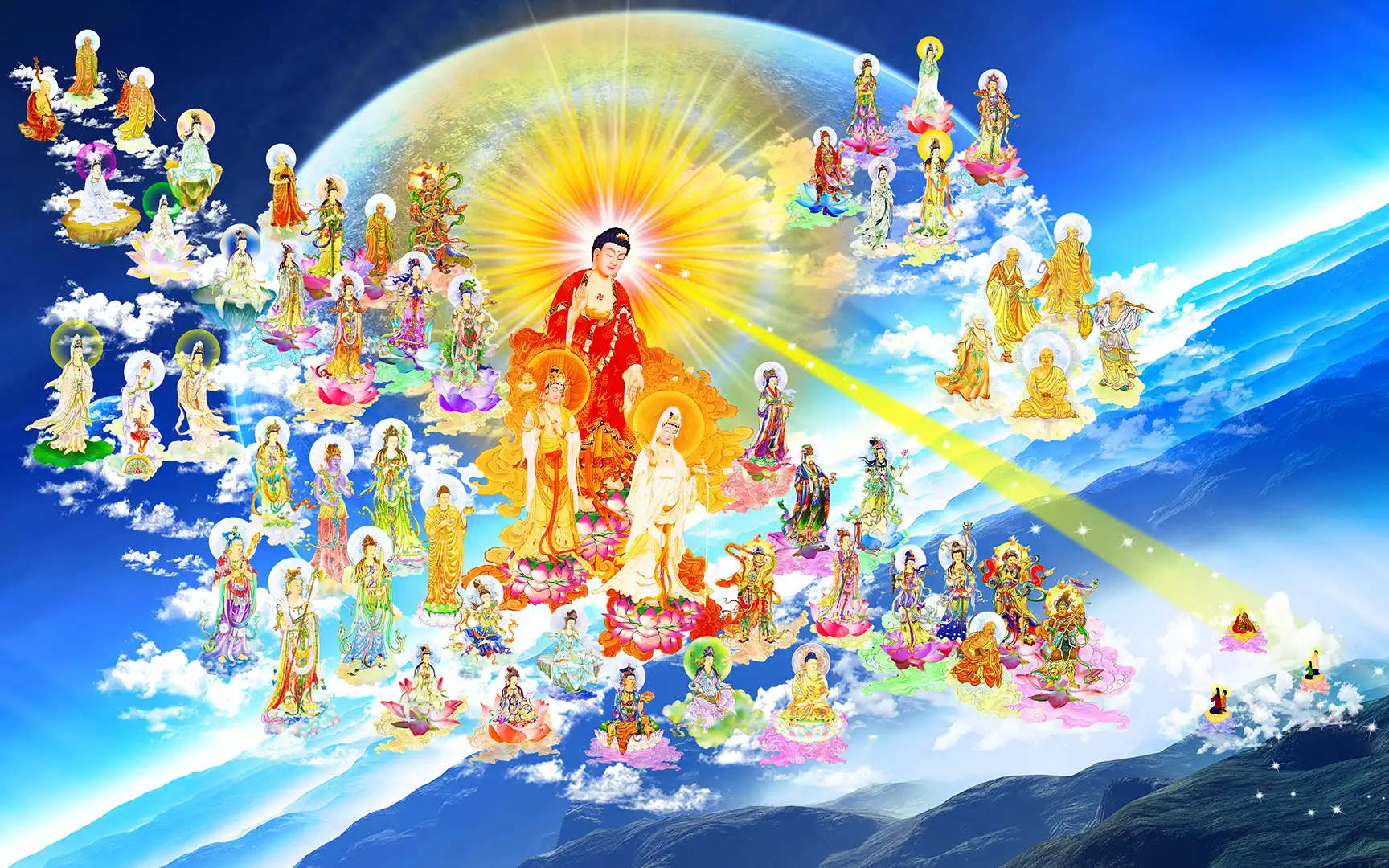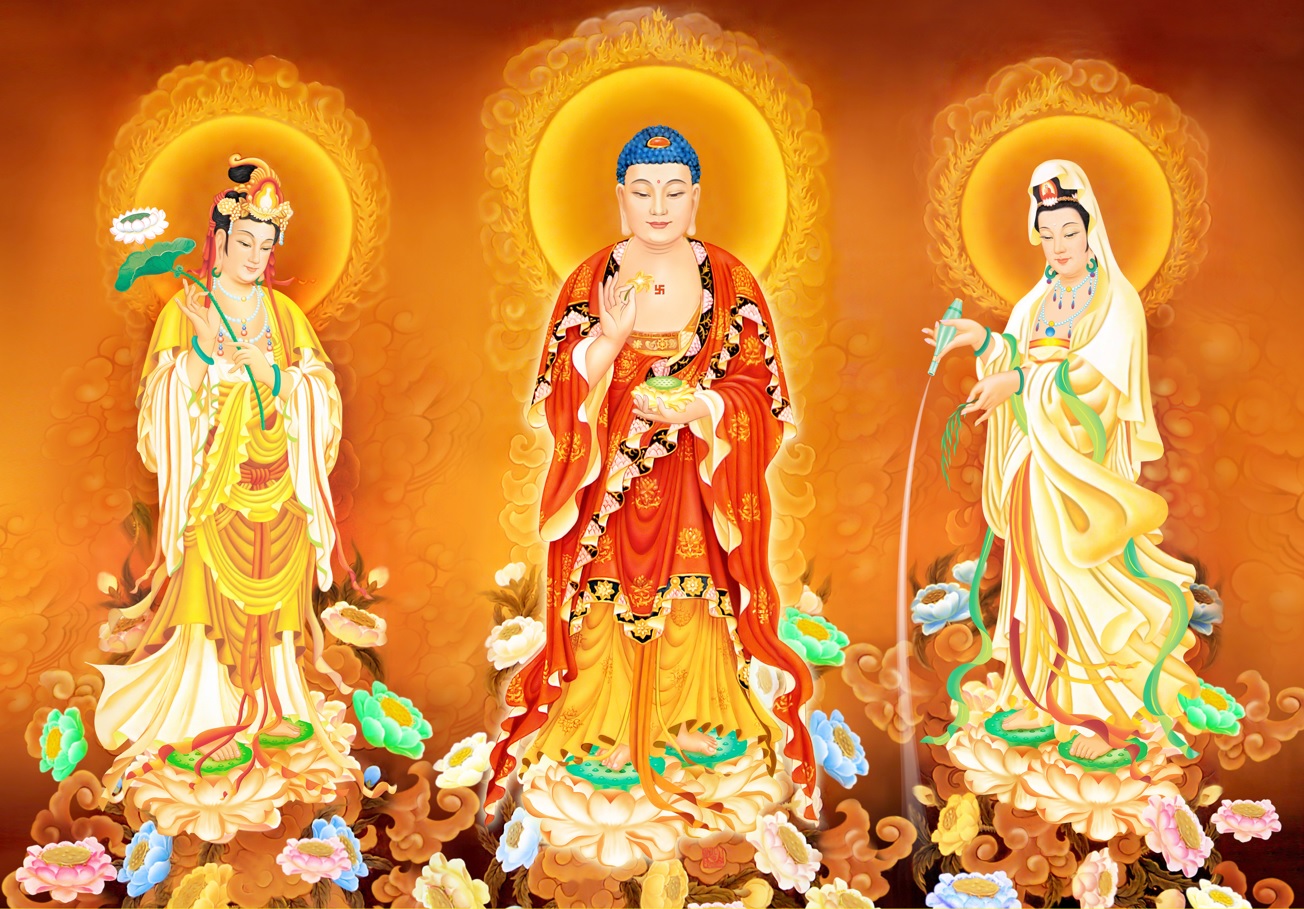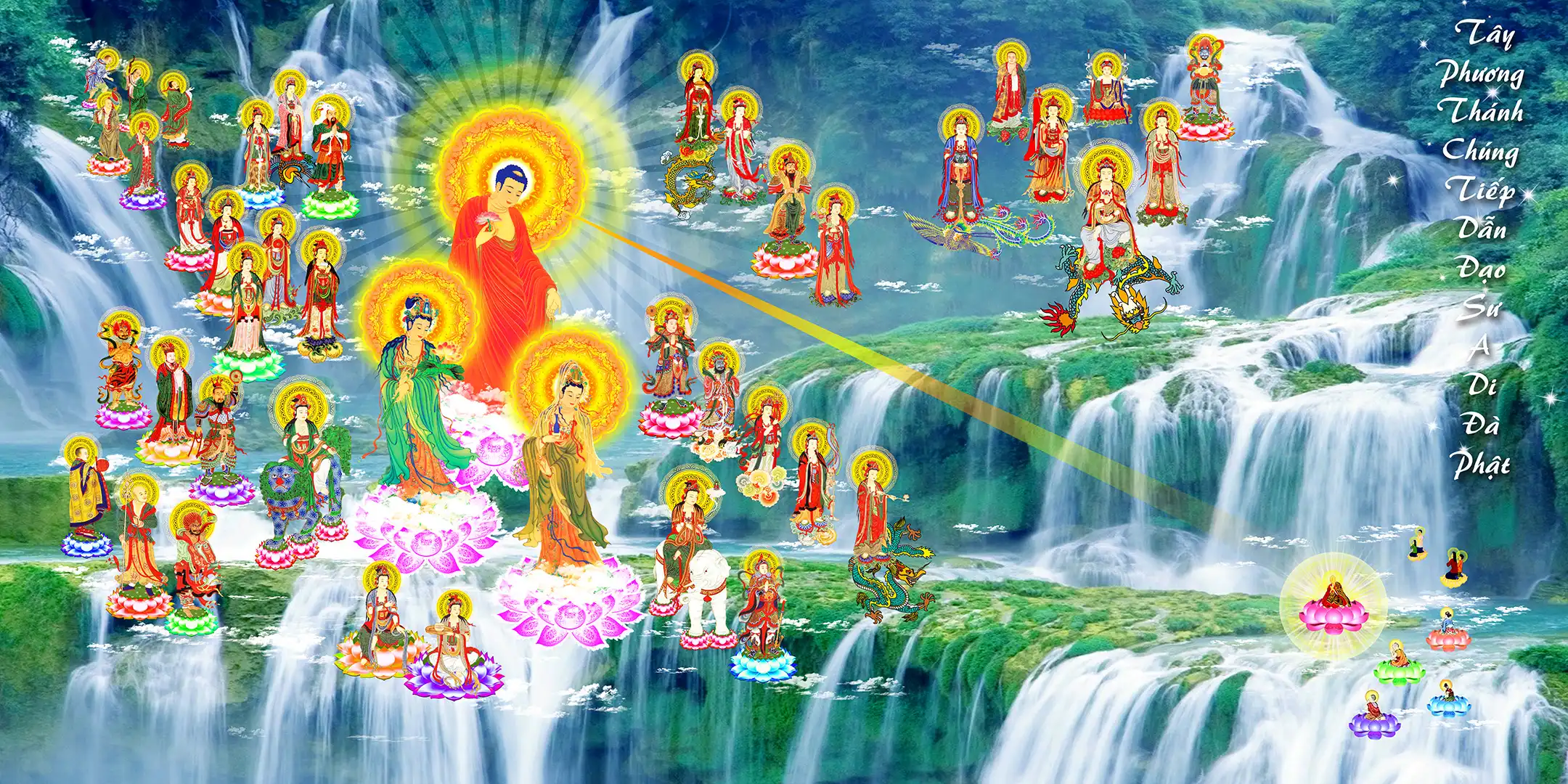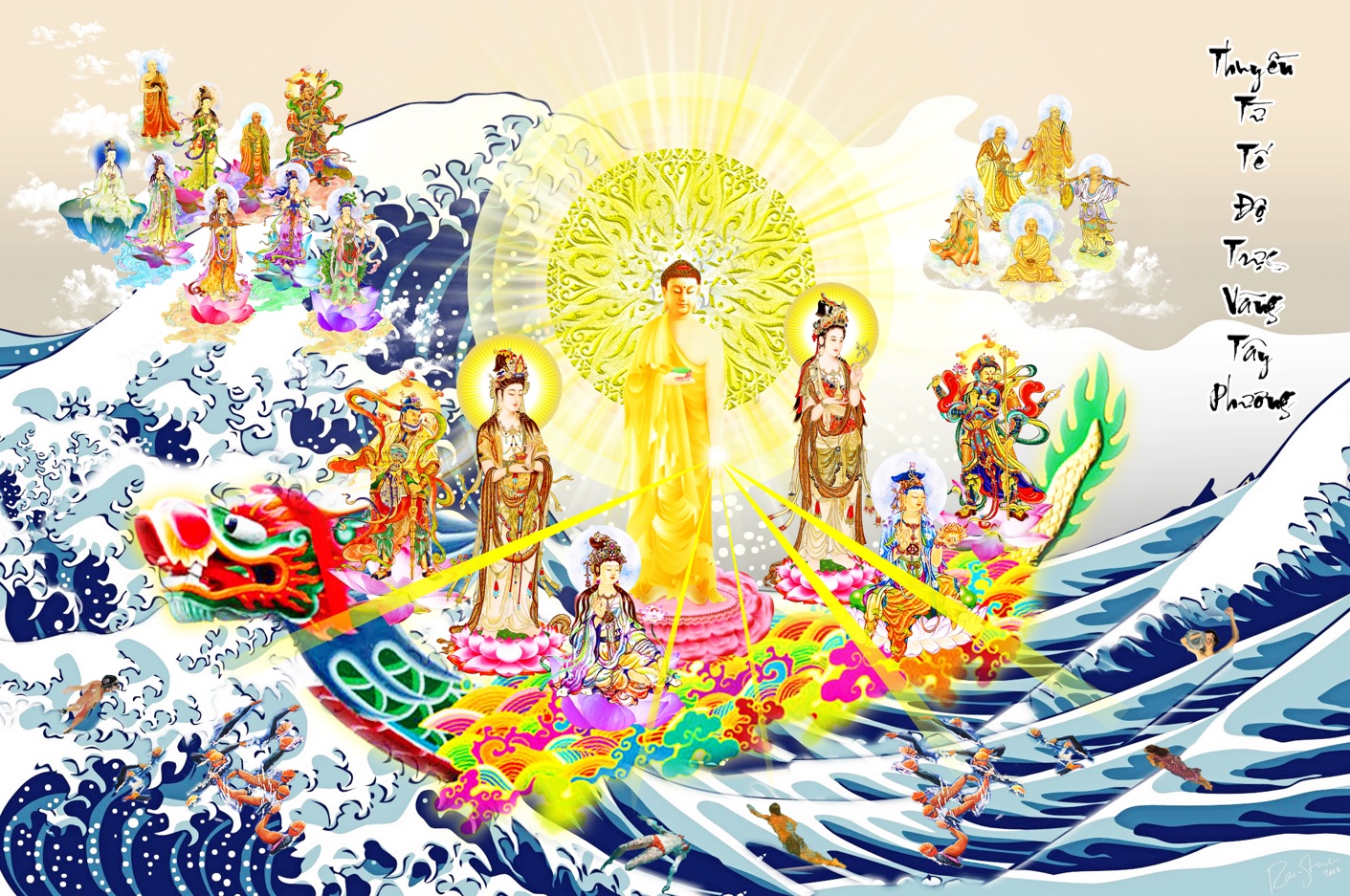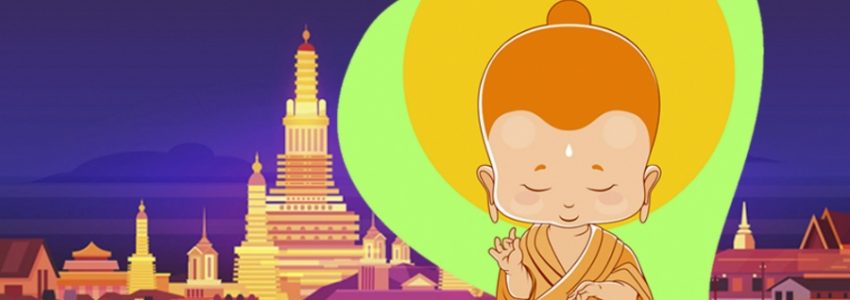THE SORROWLESS FLOWERS
Thiện Phúc
VOLUME I
151.Eight Precepts
152. Recite Buddhist Sutras
153. Recite Mantras
154. Four Reliances
155. Dharma of Liberation
156. Conditioned Dharmas
157. Dharmakshanti
158. Dharmachakra-pravartana
159. Buddha’s Teachings
160. CThe Raft of Dharma
151. Eight Precepts
Beside the lay five precepts, lay people may also take eight precepts for a period of 24 hours every month. Many lay people like to take the eight precepts on new and full moon days or on Buddhist festivals, although they may be taken on any day. The first five of these eight are similar to the five lay precepts, with the expception that the precept against unwise sexual behavior become abstinent from sex, because the precepts are kept for only one day. The sixth precept is to avoid wearing perfume, ornaments and cosmetics as well as to refrain from singing, dancing and playing music. This precept helps lay people avoid distractions to their practice. Not beautifying the body encourages lay people to cultivate their internal beauty of love, compassion and wisdom. If they sing and dance, then when they sit down to meditate, the tunes keep running throught their minds. The seventh precept is not to sit or sleep on a high or expensive bed or throne, as this could make them feel proud and superior to others. The eighth precept is not to eat solid food after noon and to be vegetarian for the day. When some masters give the the eight precepts they say only lunch may be eaten, while others allow both breakfast and lunch. Some masters permit only water to be taken in the evening, others allow tea with little milk, or fruit juice without pulp. The purpose of this precept is to reduce attachment to food. It also enables lay people to meditate better in the evenings, for if they eat a big supper, they often feel heavy and sleepy. Keeping precepts is not only better for ourselves, but it also help us increase awareness of our actions, words, and attitudes. It help us know ourselves better because we’ll become aware of our habitual actions; it also enables us to decide beforehand what actions we want to avoid, and prevent a situation in which we’re tempted to do something we know we’ll regret later. Eight precepts are given to lay Buddhists to cultivate the way and must be observed and strictly followed for one day and night include eight rules as follows: not to kill (not killing living beings), not stealing (not to take things not given), not to commit sexual misconduct (not having sexual intercourse), not to lie (not to speak falsely, not telling lies), not to drink wine (not consuming intoxicants), not to indulge in cosmetics, or personal adornments (not wearing personal decoration, not to wear make-up, fragrance, and jewelry), not to dance, sing, play or listen to music and not to sleep on fine or raised (high) beds, but on a mat on the ground, and finally not to eat out of regulation (appropriate) hours (after noon); eat only from 11 AM to 1 PM.
152. Recite Buddhist Sutras
Reciting Buddhist sutras means reflecting the meanings in the sutras, not reciting for the sake of reciting. Some sutras describe the virtues of the Buddha. If we have strong faith, reciting and reflecting on one of these sutras can give us great joy and happiness. If we do not try to practice what the Buddha taught in the sutras, it is no use to memorize the sutras. Instead of reading sutras that are profound and difficult to practice, we can recite shorter but more practical sutras, such as the Satipatthana Sutta which talks about the benefits we can enjoy through practicing the Dharma. Besides, we can read other sutras that contain inspiring stories of the Sangha, the community of noble ones. Reciting and reflecting on these sutras can fill us with inspiration, which helps lead us to the path of purification. In the Dharmapada Sutra, the Buddha taught: “The heedless man even if he can recite many sacred sutras, but fails to act accordingly; he has no share in the fruits of the monastic life, but is like a cowherd who counts the cows of the master, but has none of his own (Dharmapada 19). Even if a man recites few sutras, but acts in accordance with the teaching, overcoming all lust, hatred and ignorance, with true knowledge and serene mind, clinging to nothing here and hereafter, he shares the fruits of a monastic life (Dharmapada 20). A recitation composed of a thousand words without sense, is no better than one single beneficial word upon hearing which one is immediately pacified (Dharmapada 100). One beneficial line by hearing it one is immediately pacified is better than a thousand verses with words without sense (Dharmapada (101). One single word of the Dharma by hearing it one is immediately pacified, is better than a hundred stanzas, comprising senseless words (Dharmapada 102).”
153. Recite Mantras
The short sutras that contain magical formulas, or mantras. However, when reciting mantras, we must first have a proper and sincere mind. If our mind is not proper, then no matter which mantra we learn, it will be deviant. Generally speaking, sincere Buddhists should always remember that no matter what kind of method of cultivation we are pursuing, not only should our mind be proper, it should also be sincere. It is to say that we must devote our full attention to the method and not being the least bit of casual, sloppy, or careless. Even though demons always want to harm people, genuine cultivators would never harm anyone under any circumstances. On the contrary, we should always want to benefit beings. Sincere Buddhists should always remember that we recite mantras to develop our compassionate mind and make sure that we do not have even the thought of harming others. We do not recite mantras to to subdue demons and ghosts or fight people.
Dharani, especially mantra or spell, is emphasized by the Shingon sect. Dharani is a Sanskrit word that means to maintain or preserve the power of wisdom or knowledge. Able to hold on of the good so that it cannot be lost, and likewise of the evil so that it cannot arise. “Dharani” also means “uniting and upholding”, because it unites all dharmas and upholds limitless meanings. All dharmas originate from this source. Dharani is also a synonyme for “mantra”. Dharani is a Sanskrit word, interpreted to mean ‘unite and hold.’ Dharani is sometimes called mantras, unite all dharmas and hold limitless meanings. They are the chief or the head of all dharmas. A verse of mystical syllables, abbreviation of a sutra to its essential elements (short sutra that conains magical formulas comprised of syllables of symbolic content or mantra). An invocation, usually longer than a Mantram which has magical powers in its recitations. Mantras are mystical or magical formulas employed in Tantric Buddhism (mantras of the esoteric vehicle, or Diamond vehicle). In Lamaism dharani consist of sets of Tibetan words connected with Sanskrit syllables. Entire control or absolute control over good and evil passions and influences. Maintain or preserve the power of wisdom or knowledge. Able to hold on of the good so that it cannot be lost, and likewise of the evil so that it cannot arise. Dharani: Dharani, especially mantra or spell, is emphasized by the Shingon sect. Mantras are magical formulas, or mystic forms of prayer, or spells of Tantric order, often in Sanskrit, found in China as early as the third century A.D.; they form a portion of the Dharanipitaka; made popular chiefly through the Yogacarya or esoteric school.
A Sanskrit term for “Tantra” means “thread.” Tantra also means various kinds of texts, or discourse attributed to Sakyamuni Buddha, but only appeared some time around the seventh century in India. In Tantric school, tantra means secret texts spoken by the Buddha for a specific person and rewritten by his disciples. So “Tantra” means system or continuum of the Buddha’s secret words on spiritual development. In Tantric school, tantra means secret texts spoken by the Buddha for a specific person and rewritten by his disciples. So “Tantra” means system or continuum of the Buddha’s secret words on the spiritual development. The term ‘Mantra’ or ‘Vidya’ is not intended to mean ‘a secret, mysterious lore of magical potency which can be compressed into a magical formula, a spell’. Rather, the term is intended to mean, ‘the knowledge of the Four Holy Truths’ which is fundamental insight of the Buddha. In parallel to ‘The First Turning of the Wheel’ the main subject of which is the Four Holy Truths. Mantra is a secret holy saying or secret teaching of Buddhas whose primary meaning or meanings is not cognitive, but on a spiritual level that transcends ordinary linguistic understanding. Mantra is also used for an incantation, spells, magical formula, muttered sound, or secret words of Buddhas. A magical formula or invocation believed to have magical powers, used in tantric Buddhism in Tibet, a power-ladden syllable or series of syllables that carry cosmis forces or energies. “Mantra” is derived from the Sanskrit root “man” which means “to think” or “to imagine.” “Mantras” are designed as tools for focusing the mind through repetition. In certain Tantric Buddhism, continuous repetition of mantras is practiced as a form of meditation (to concentrate energy on an object to create spiritual power). A mystical verse or magical formula, incantation, charm, spell. In Pure Land sects, Buddhists utilize the mantra “Namo Amitabha Buddha” (Namo Amida Butsu—jap). Mantras are also widely used in Vajrayana traditions. They usually invoke the power of a particular buddha, and are used both as a meditative aid and as magical spells that are believed to provide protection and worldly benefits. According to the Buddhist tradition, mantras have four benefits for cultivators: help curing an illness, eradicating offenses, producing good on the path of cultivation, and entering the truth. One should not translate mantra under any form for except the Buddhas and the sages, no one else can really understand the real meaning of the mantra. According to Most Venerable Hsuan-Hua, the saying of a mantra is like the secret password of the military. If the reply is correct, there is no further question, everything will be fine. If the reply is incorrect, one is punished. So we must be very careful.
According to Dharma Master Thich Thien Tam in the Unisha Vijaja Dharani Sutra, in all the greatest Dharani of the Buddha, this mantra is the best, unequaled, often eliminating suffering for all sentient beings in all the six realms of existence. According to the Sutra of the Heart of Great Compassion Mantra, Avalokitesvara Bodhisattva (Kuan-Yin) said to the Buddha: “Great Honored Teacher! If any sentient being should assiduously recite the Great Compassion Mantra and still descend upon the Three Evil Paths, I vow not to attain Buddhahood. If any practitioner should assiduously recite the Great Compassion Mantra and fail to be reborn in the lands of the Buddhas, I vow not to attain Buddhahood. If any practitioner should assiduously recite the Great Compassion Mantra and not to achieve innumerable samadhis and great eloquence, I vow not to attain Buddhahood. If anyone should assiduously recite the Great Compassion Mantra and not have all wishes and hopes of his present life fulfilled, this dharani cannot be called the Great Compassion Mantra! The only exceptions are wishes which are unwholesome and those made when the Mind is not utterly sincere.””Moreover, practitioners who assiduously recite such dharani as the Thousand-Armed Avalokitesvara Mantra, the Rebirth Mantra, etc. with utmost sincerity, can all be reborn in the Western Pure Land or other pure lands.
According to Tibetan Buddhism, Kalacakra-tantra is one of the most important Indian tantric texts for Tibetan Buddhism. It consists of three parts: inner, outer, and other. The firs part discusses the external world. The second part focuses on the psycho-physical world of sentient beings, particularly the mystical physiology of subtle energies called “winds” (prana—skt), and “drops” (bindu—skt), which to through subtle “energy channels” (nadi—skt). The third section is concerned with visualization practices. The Kalacakra was probably one of the latest Tantras produced in South Asia, some scholars believed that it was probably composed in or near Sogdiana in the tenth century, and it was not transmitted to Tibet until 1027. The text says that it was spoken on the fifteenth day of the third month after Sakyamuni Buddha’s awakening. At the time he appeared on the Vulture Peak dressed in monk’s robes and preached the “Perfection of Wisdom Sutra” in 100,000 lines, and he simultaneously manifested at Dhyanakataka in South India as the Buddha Kalacakra, in which form he taught the Kalacakra tantra. The tantra is said to have been spoken at the request of Sucandra, king of Sambhala and an emanation of the Buddha Vajrapani, who complied the tantra in its long form, said to be twelve thousand verses, but no longer extant. Its central practice is a six session yoga: 1) individual withdrawal (of winds); 2) concentration; 3) stopping vitality; 4) retention; 5) subsequent mindfulness; and 6) meditative absorption. The initial stages are techniques for withdrawing the winds into the central channel (avadhuti—skt). In the sixth branch one actualizes immutable bliss, which is the object of Kalacakra practice. In Tibet the tantra forms the basis of the traditional astrological calendar and the medical system. Yearly Kalacakra initiation ceremonies given by the Dalai Lama are among the most popular events of Tibetan Buddhism today, because it is widely believed that receiving the Kalacakra empowerment ensures rebirth in Sambhala.
Mantras of the Vajrayana “Om”. Sanskrit syllable that is often found at the beginning of Buddhist Mantras. It was inherited from Hinduism, and there are various explanations of its meaning. One common notion found in Mahayana literature is that it symbolizes the fundamental nature of reality, i.e., emptiness (sunyata). This word is also used to show solemn affirmation and respectful assent. Sometimes translated by “Yes.” This is the most comprehensive and venerable symbol of spiritual knowledge in Vajrayana. Om is a symbol of form as well as sound. This is not a magic word. In fact this is not even considered to be a word at all. It is rather a manifestation of spiritual power, symbol that is to be found throughout the East. Om, aum; “a word of solemn affirmation and respectful assent, sometimes translated by yes, verily, so be it, and in this sense compared with Amen in Catholic.” It is the mystic name for the Hindu triad, and has othe significations. It was adopted by Buddhism, especially by the Tantric school, as a mystic spell, and as an object of meditation. It forms the first syllable of certain mystical combinations, e.g. Om mani padmi hum, which is a formula of the Tibetan Lamaistic branch, said to be a prayer to Padmapani; each of the six syllables having its own mystic power of salvation from the lower paths of transmigration, etc.; the formula is used in sorcery, auguries, etc..
Mantra “Om-Mani-Padme-Hum” or “Great compassion mantra”. A formula of Lamaistic branch. Each of the six syllables having its own mystic power of salvation the lower paths of transmigration. The Mantra of Avalokitesvara, who in Mahayana is said to be the embodiment of compassion (karuna). It is the most commonly chanted mantra in Tibetan Buddhism, probably due to the fact that Avalokitesvara is widely viewed as being particularly closely associated with Tibet and its history. Several of the most prominent lineages of reincarnating lamas (sprul Sku-tib), including the Dalai Lamas and the R Gyal Ba Kar Ma Pas are believed to be physical manifestations of Avalokitesvara. The meaning. The meaning of the mantra has been debated by contemporary scholars. Some read “padme” (lotus) as a Sanskrit locative, in which case it would be translated as “om” Jewel in the Lotus “hum.” Others interpret “padme” as a vocative feminine, and thus translate it as “Om Jewel-Lotus hum.” Both readings are, however, problematic: in the first interpretation the mantra would be ungrammatical, which is not uncommon with Buddhist Sanskrit mantras; and the second interpretation faces the problem of why a male buddha would be referred to with a feminine vocative. This is the most important and oldest mantra of Tibetan Tantric Buddhism. These six syllables are an expression of the basic attitude of compassion, and the recitation of them expresses the longing for liberation.
Devout Buddhists should always remember that to have faith in “mantras” in Buddhism does not have the same meaning as to have faith in worldly charms. In Vietnam, there still exist some local customs of worldly charms, incantations, observance of lucky hours, bad hours, lucky days, bad days, and devil dancing, and so on. In the Brshmajala Sutra, we can see clearly that these customs are totally contradictory with the Buddhist fundamental principles. They are the surviving bad customs of fetishism and pantheism, as well as other heretic religions. The Buddhist Tantras in outward appearance resemble the Hindu Tantras to a marked degree, but in reality there is very little similarity between them, either in subject matter or in philosophical doctrines, or in religious principles. This is not to be questioned at, since the aims and objects of Buddhists are widely different from those of the Hindus.” The main difference is that Buddhist Tantra is not Saktism. The concept of Sakti, of divine power, of the creative female aspect of the highest God (Siva) or his emanations does not play any role in Buddhism, while in the Hindu Tantras, the concept of power (sakti) forms the focus of interest. The central idea of Tantric Buddhism, however, is prajna (knowledge, wisdom). To the Buddhist, sakti is “maya,” the very power that creates illusion, from which only Prajna can liberate us. It is, therefore, not the aim of the Buddhist to acquire power, or to join himself to the power of the universe, either to become their instrument or to become their master, but, on the contrary, he tries to free himself from those powers, which for aeons kept him a prisoner of samsara. He strives to perceive those powers, which have kept him going in the rounds of life and death, in order to liberate himself from their dominion. However, he does not try to negate them or to destroy them, but to transform them in the fire of knowledge, so that they may become forces of enlightenment which, instead of creating further differentiation, flow in the opposite direction: towards union, towards wholeness, towards completeness. The attitude of the Hindu Tantras is quite different, if not contrary. “United with the Sakti, be full of power,” says the Kulacudamani Tantra. “From the union of Siva and Sakti the world is created.” The Buddhist, on the other hand, does not want the creation and unfoldment of the world, but the coming back to the “uncreated, unformed” state of sunyata. From which all creation proceeds, or which is prior to and beyond all creation (if one may put the inexpressible into human language).
154. Four Reliances
In Buddhim, human languages include teaching, recitation, and stories, etc. In the Lankavatara Sutra, the Buddha taught: “It is owing to his not perfectly understanding the nature of words that he regards them as identical with the sense.” The Buddha emphasized the inner attainment of the truth, not the teaching realized by all the Tathagatas of the past, present, and future. The realm of the Tathagatagarbha which is the Alayavijnana belongs to the cultivation that follows the course of truth and not to those philosophers who cling to the letter, learning, and mere discourse. In order to attain the Bodhi fruit, cultivators should rely on the teachings, the discourses definitive meaning, the meaning of the teaching, and the intuitive wisdom. Therefore, the Buddha always reminded the four assemblies to rely on the four basic principles for thorough understanding Buddhism and cultivation. First, trust the teaching, not the person. Trust in the Law, not in menor relying in on the teaching, not merely on any persons or trust in the truth which is eternal, rather than in man, even its propagator (relying on the teaching and not on the person who teaches it—rely not on the person, but on the doctrine). Second, trust discourses definitive meaning, not discourses of interpretable meaning. Relying on sutras that give ultimate teachings, not on those which preach expedient teachings. Trust in sutras containing ultimate truth or trust in the perfect meaning (the truth of the middle way) of the sutras. That is to say “rely not on the interpretable meaning, but on the definitive meaning. Relying on the sutras that give ultimate teachings, not on those which preach expedient teachings. Third, trust the meaning of the teaching, not the expression. Trust in truth, not in words or trust in the meaning or spirit, not the letter. Rely on the complete teaching, not on the partial teaching or trust in sutras containing ultimate truth, not incomplete one. Relying on the sutras that give ultimate teachings, not on those which preach expedient teachings (rely not on the words, but on the meaning; relying on discourses of definitive meaning, not on discourses of interpretable meaning). Relying on the true meaning or spirit of Dharma statement in sutra, not merely on the words of the statement (relying on the meaning of the teaching and not on the expression). Fourth, relying on intuitive wisdom, not on intellectual understanding. Trust intuitive wisdom, not normal consciousness—With respect to the definitive meaning, trust in wisdom growing out of eternal truth and not in illusory knowledge (trust in the Buddha’s wisdom rather than mere knowledge. Rely on knowledge, not on conditioned consciousness. Trust in wisdom growing out of eternal truth and not in illusory knowledge. Relying on intuitive wisdom, not on intellectual or normal understanding. Relying on intuitive wisdom and not on normal consciousness). That is to say “One should not rely on comprehension by an ordinary state of consciousness, but on understanding by an exalted wisdom consciousness.
155. Dharma of Liberation
Generally speaking, all teachings of the Buddha are aimed at releasing human beings’ sufferings and afflictions in this very life. They have a function of helping individual see the way to make arise the skilful thought, and to release the evil thought. For example, using compassion to release ill-will; using detachment or greedilessness to release greediness; using wisdom or non-illusion to release illusion; using perception to release selfishness; using impermanence and suffering to release “conceit.” For lay people who still have duties to do in daily life for themselves and their families, work, religion, and country, the Buddha specifically introduced different means and methods, especially the Buddha’s teachings in the Advices to Lay People (Sigalaka) Sutra. The Buddha also introduced other methods of cultivation: “To abandon four wrong deeds of not taking life, not taking what is not given, not committing sexual misconduct, not lying, not doing what is caused by attachment, ill-will, or fear, not to waste one’s substance by the six ways of not drinking alcohol, not haunting the streets at unfitting time, not attending nonesense affairs, not gambling, not keeping bad company, and not staying idle. In addition, lay people should always live in the six good relationships of their families and society: between parents and children, between husband and wife, between teacher and student, among relatives and neighbors, between monks and lay people, between employer and employee, etc. These relationships should be based on human love, loyalty, sincerity, gratitude, mutual acceptance, mutual understanding and mutual respect because they relate closely to individuals’ happiness in the present. Thus, the Buddha’s Dharma is called the Dharma of liberation.
156. Conditioned Dharmas
Active, conditioned, produced or functioning dharmas are all phenomena which are influenced by the production or birth, duration or existence, change, and annihilation. All conditioned states are impermanent and passing away. This is one of the four great voices of the Buddha, “You should know that the myriad pains of all conditioned states are as searing as balls hot iron. Conditioned states are impermanent and pass away. Nirvana is tranquil, unfabricated well-being, beyond all burning, extinguishing all inflaming afflictions.” Having heard this, sentient beings diligently practice good principles, and in the vehicle of listeners to Buddha’s voice attain the tolerance of conformity to the message. All conditioned states are miserable. This is one of the four great voices of the Buddha, “You all should know that all conditioned states are miserable. There is the misery of hells, the misery of animality, the misery of hungry ghosthood, the misery of lack of virtue, the misery of clinging to self and possessions, the misery of evildoing. If you want to be born human or divine, you should plant roots of goodness. Born in the human world or in a heaven, you will leave all situations in which enlightenment is difficult.” Sentient beings, having heard this, give up error and perversity, practice good actions, leave all difficulties behind, and are born in the human world or in heaven. All conditioned states are without a Self means the body has no-self; the mind has no-self; and the environment has no-self. When Sakyamuni Buddha put forth the notion of “no-self,” he upsets many concepts about life in the universe. He blasted our most firm and widespread conviction, that of a permanent self. Those who understand “not self” know that its function is to overthrow “self,” not to replace it with a new concept of reality. The notion of “not self” is a method, not a goal. If it becomes a concept, it must be destroyed along with all other concepts. As long as we still cling to the self, we will always have to defend ourselves, our property, our prestige, opinions, and even our words. But once we give up the belief in an independent and permanent self, we will be able to live with everyone in peace and pleasure. The Buddha taught: “Understanding not-self is a key to great enlightenment for the belief in a self is synonymous with ignorance, and ignorance is the most basic of the three afflictions (greed, anger, and stupidity). Once we identify, imagine, or conceive ourselves as an entity, we immediately create a schism, a separation between ourselves and the people and things around us. Once we have this conception of self, we respond to the people and things around us with either attachment or aversion. That’s the real danger of the belief of a self. Thus, the rejection of the self is not only the key of the end of sufferings and afflictions, but it is also a key to the entrance of the great enlightenment.”
157. Dharmakshanti
Dharmakshanti means acceptance of the statement that all things are as they are, not being subject to the law of birth and death, which prevails only in the phenomenal world created by our wrong discrimination. Patience attained through dharma to overcome illusion. Also, ability to bear patiently external hardships. Dharma door of patience (Dharma gate of Patience) is among the six paramitas, the Dharma door of patience is very important. If we cultivate the Dharma door of patience to perfection, we will surely reach an accomplishment. To practice the Dharma door of patience, one must not only be hot tempered, but one should also endure everything.
158. Dharmachakra-pravartana
These two extremes, devout Buddhists, are not to be approached by him who has withdrawn from the world. Which two? On the one hand that which is linked and connected with lust through sensuous pleasures (kamesu) and is low; ignorant, vulgar, ignoble and profitless; and on the other hand that which is connected with self-mortification, and is painful, ignoble and profitless. The Buddha taught: “Now this, O monks, is the noble truth of pain; birth is painful, aging is painful; sickness is painful, death is painful. Contact with unpleasant things is painful, separation from pleasant things is painful and not getting what one wishes is also painful. In short, the five ‘khandhas’ of grasping are painful. Now this, O monks, is the noble truth of the cause of pain; that craving, which leads to rebirth, combined with pleasures and lust, finding pleasure here and there, namely the craving for passion, the craving for existence, the craving for non-existence. Now this, O monks, is the noble truth of the cessation of pain: the cessation without a remainder of that craving, abandonment, forsaking, release, non-attachment. Now this, O monks, is the noble truth of the way that leads to the cessation of pain: this is the Noble Eightfold Path, namely Right Views, Right Intention, Right Speech, Right Action, Right Livelihood, Right Effort, Right Mindfulness, Right Concentration.”
159. Buddha’s Teachings
The birth of the Buddha’s teachings is the pinnacle of the Buddha’s achievement. The Buddha’s enlightenment was in some respects the pinnacle of his achievement, but it was his subsequent teaching of Dharma (Truth) that laid the foundation for his enduring legacy. The community of monks and nuns that he established ensured the transmission of this doctrine to future generations, and in the 3rd century B.C. the reign of the emperor Asoka played an instrumental role in the dissemination of Buddhism in India. After he had attained enlightenment, the Buddha remained for seven weeks at the site of the Bodhi Tree and enjoyed great bliss. During this period he realized that what he had come to understand was a profound and difficult truth, which other people relished worldly attachment, would find hard to grasp. According to the Buddha, the Buddha-dharma is simply worldly dharma in which we turn ourselves around. It is the dharma that most ordinary people are unwilling to use. Worldly people are sinking and floating in the worldly dharma; they are always busy running here and there, constantly hurried and agitated. The source of all these activities is invarably selfishness, motivated by a concern to protect their own lives and properties. Buddha-dharma, on the other hand, is unselfish and public-spirited, and springs from a wish to benefit others. Sincere cultivators always think of others’ welfare. Sincere cultivators always forget their own “Ego”. They always give up their own interests in service to others, and never bring uncomfortable circumstances and afflictions to others. However, most people fail to clearly understand the basic ideas that the Buddha once preached. As a result as we can see now, within Buddhist circles we find struggle and contention, troubles and hassles, quarrels and strife. These problems seem to be no different from that of ordinary people, if we do not want to say worst than what we can find in worldly life. The Buddha predicted all these problems, thus He concluded that it would be pointless to try to teach others about his enlightenment, but the great god Brahma Sahampati intervened and implored the Buddha to share his discoveries with humankind.
The great god Brahma Sahampati intervened and implored the Buddha to share his discoveries with humankind. Impelled by his great compassion, the Buddha decided to survey the world. He saw that beings are of different kinds: like lotuses in a pond, some are immersed underwater, other grow and rest on the surface, and other again come right out of the water and stand clear, He understood that just as some people have good qualities and others bad, some would be easy to teach and others would be difficult. Because of this diversity and out of his great compassion for all beings, the Buddha changed his mind and resolved to teach. The Buddha’s first sermon was addressed to the five ascetics who had been his companions before the enlightenment. At the deer park at Sarnath, near present day Varanasi, he explained to them the content of his enlightenment in the form of the Four Noble Truths. These ascetics were so struck by the depth of his insight and the novelty of his message that one of them instantly became an arhat, a “worthy one” who attains nirvana through a Buddha’s teaching. The other four followed suit in the days to come. This momentous first sermon, which has become one of the better-known articulations of the Buddha’s teaching and of Buddhism in general, is called the “Setting in Motion of the Wheel of Dharma.” It is still celebrated in most Theravada countries in the festival called “Asalha Puja,” which takes place on the full moon day of the month of July.
For the next forty-five years, until his ultimate extinction, the Buddha taught Dharma. The number of his followers increased steadily and the community of monks, the Sangha, began to form. The Buddha himself continued wandering and begging for his food. He taught indiscriminately, talking to kings and paupers alike, and ceased traveling only in the three months of the rainy season. The Buddha did not appoint a successor. When his disciples asked who would lead them after his death, he retorted that they must turn to themselves and be guided by the Dharma as he had taught it to them. It would be the duty of the Sangha to maintain the Dharma when he was gone. At his death approached, the Buddha asked the assembled monks if they had any questions. The gathering remained silent. The Buddha’s last words to the monks were: “All things composed are perishable. Now strive diligently.” Then, lying on his right side between two “sal” trees, he began meditating into the many stages of his complete and final extinction (parinirvana), after which he would never again be reborn. His body was cremated and, in accordance with his wish, the remains were divided among humans and gods. Stupas (dome-shaped funerary mounds) were erected over the relics. Stupas can be seen today at such sites as Sanchi and Amaravati in India, Anuradhapura in Sri Lanka and Borobudur in Indonesia.
160. The Raft of Dharma
From beginningless eons in the past, we have died and been reborn, over and over, passing through hundreds of thousands of Asankhyas. During all this time, we have never encountered the Buddha-dharma, so our bad habits and faults have not decreased by the slightest bit. In fact, our ignorance and afflictions have increased day by day. Now that we have encountered the Buddha-dharma, we might say that the roots of goodness we have planted throughout measureless eons in the past have matured, enabling us to meet the wonderful and inconceivable Dharmas. Someone who lacked these roots of goodness, who has no virtuous practices, would never have the chance to encounter the Buddha-dharma. Therefore, we should cherish our precious time, do not let the time pass in vain. In the Alaguddùpama Sutta, the Buddha compares the dharmas to a raft which has to be left off after crossing the stream; they are not meant to be taken as ultimate tenet. In Buddhism, dharma refers to all the methods of cultivation taught by the Buddha which lead to ultimate enlightenment. They are means that lead to an end, not an end themselves. The Buddha’s teaching is likened a raft for going the other shore. All of us depend on the raft of Dharma to cross the river of birth and death. We strive with our hands, feet, and wisdom to reach the other shore. When the goal, the other shore, is reached, then the raft is left behind. The form of teaching is not final dogma but an expedient method. According to the Discourse on the Water Snake’s Parable, the Buddha taught: “My teaching is like a raft for crossing over, not for carrying.” Also according to the Middle Length Saying, the Buddha taught: “The dharma that I teach is like a raft. Even Dharma should be relinquished, how much the more that which is not Dharma? The Raft of Dharma is for crossing over, not for retaining.”
